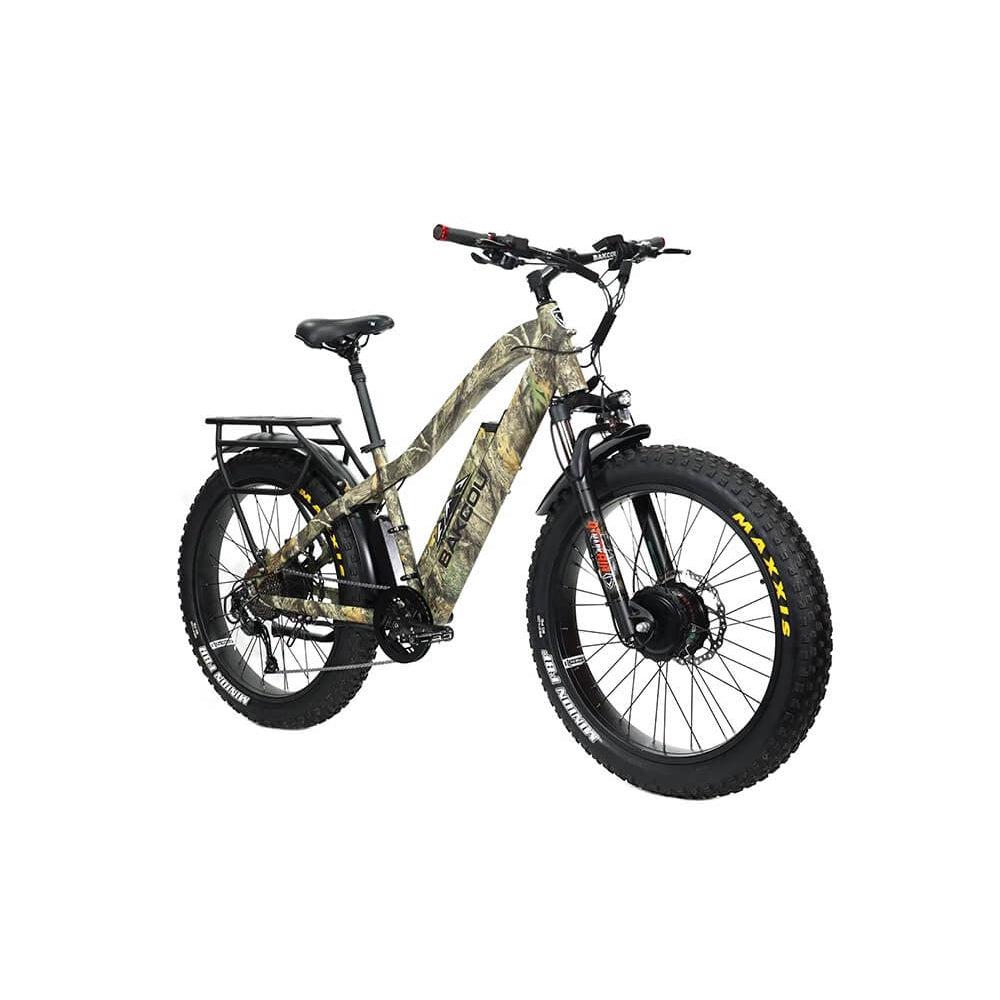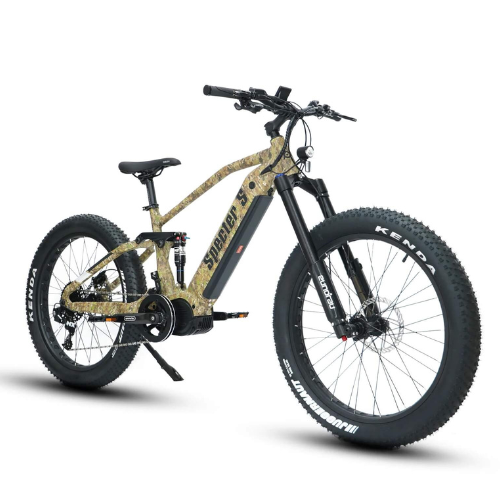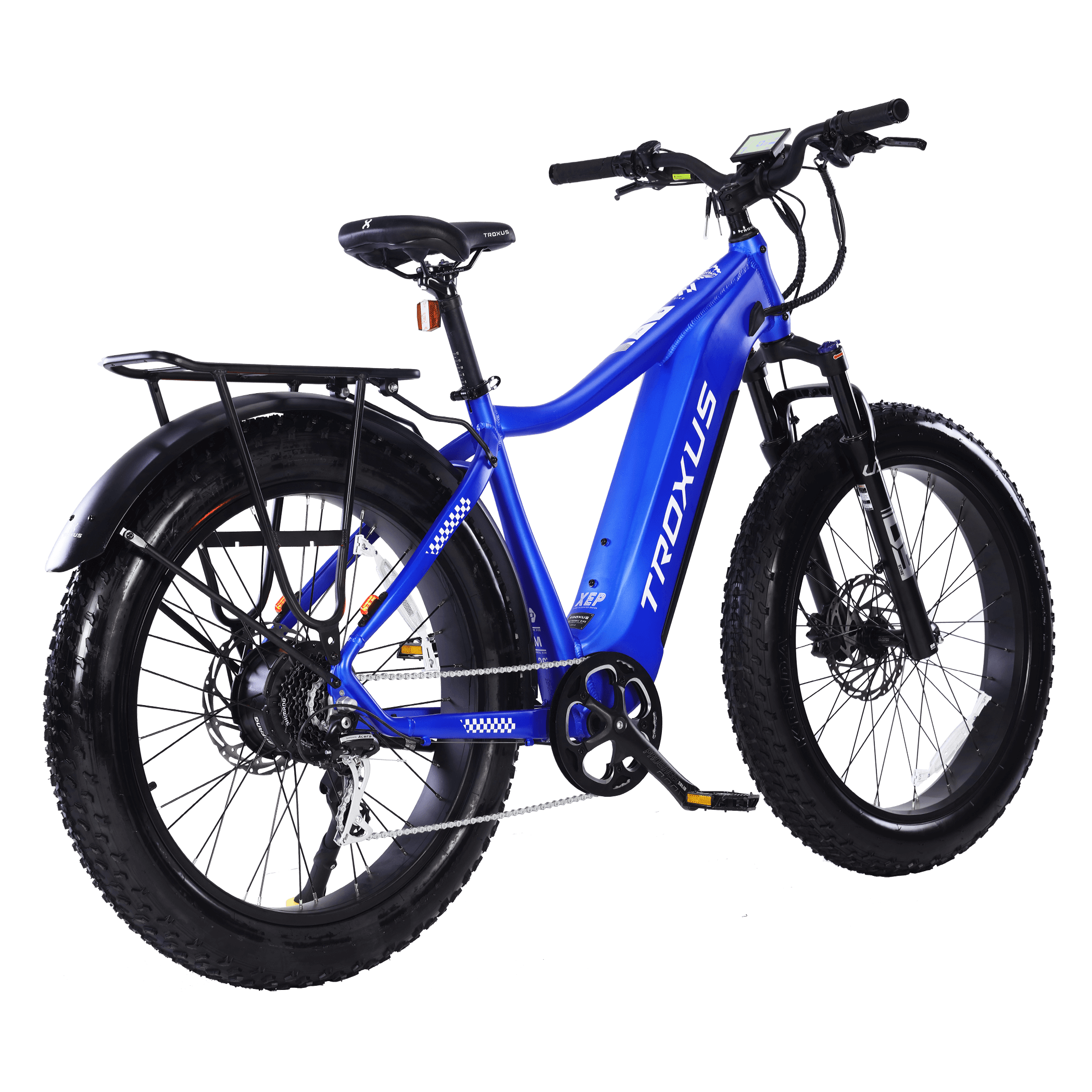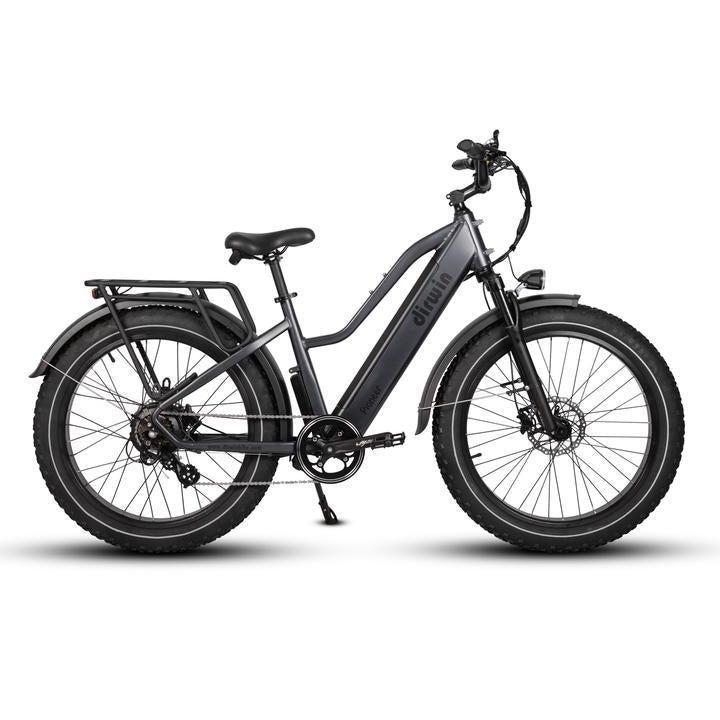Your Cart is Empty
Menu

The Best E-Bikes for Snow: Your Ultimate Guide to Winter Cycling
October 24, 2025

Traditional cyclists often find themselves hanging up their helmets until spring. Frigid temperatures and icy roads can turn even the most scenic bike path into a treacherous obstacle course. But what if there was a way to extend your cycling season and conquer winter's challenges with ease? Enter e-bikes – your trusty steed who has emerged as a game-changer for winter cycling. With the right model and preparation, you can ride through winter with confidence, enjoying the unique beauty of snow-covered landscapes.
Key Takeaways
-
Snow e-bikes are built with fat tires, powerful motors, and cold-resistant components to handle winter riding conditions.
-
Choosing the right snow e-bike involves considering tire grip, motor torque, battery performance, and braking reliability.
-
With proper gear, maintenance, and riding techniques, e-biking in snow can be safe, fun, and practical all winter long.
In this guide, we'll discuss the world of winter e-biking, exploring the factors that make an electric bike ideal for snowy conditions and highlighting some of the best models on the market.
What Is a Snow E-Bike and How Does It Differ from Regular E-Bikes?
A snow e-bike is not a completely different bike; it is a regular e-bike built to handle snowy, icy, and cold conditions. Unlike typical commuter or road e-bikes with thin tires and less powerful motors, snow e-bikes have fat tires for better grip and flotation on soft snow, stronger motors for extra torque, weather-sealed parts, and batteries optimized for cold weather. Some even use studded tires for icy patches. While you can ride a regular e-bike in winter, a snow e-bike is designed to keep you safer and perform better when the roads are slippery and harsh.

Top E-Bike Picks for Snowy Conditions

| Feature | Motor | Battery | Tires | Drive Mode | Key Features |
| BAKCOU KODIAK AWD | Dual 500W Bafang Hub | 48V/25Ah | 26" x 4.0" Maxxis Minion | 9-Speed Shimano Alivio w/ Thumb Throttle | AWD, Coil Suspension, LCD Display |
| EUNORAU SPECTER-S | 1000W Bafang Mid-Drive | 48V/17.5Ah (Dual Optional) | 26" x 4.0" Kenda Krusade | 11-Speed SRAM NX w/ 5-Level PAS & Throttle | Full Suspension, Hydraulic Brakes, Integrated Battery Option |
| TROXUS EXPLORER | 750W Bafang Rear Hub | 48V/20Ah | 26" x 4.0" Kenda x Krusade | 8-Speed Shimano w/ 5-Level PAS & Throttle | Front Suspension, Hydraulic Brakes, Rear Rack, LCD Display |
| AVENTON AVENTURE | 750W (1130W peak) Bafang Rear Hub | 48V/15Ah | 26" x 4" Kenda Krusade | 8-Speed Shimano w/ Thumb Throttle | Front Suspension, Integrated Lights, Fenders, Color Display w/ App |
| DIRWIN PIONEER | 750W Dirwin Rear Hub | 48V/15Ah | 26" x 4" Kenda | 7-Speed Shimano Altus w/ 5-Level PAS | Step-Thru Frame, Powerful Headlight, Removable Battery |
The following e-bikes are standouts when it comes to tackling winter's challenges:
1. Bakcou Kodial AWD 500W Dual Hub Motor fat Tire Ebike

The Bakcou Kodiak is a powerhouse built for the toughest conditions, including snow and ice. It features dual 500W Bafang hub motors that deliver 85Nm of torque each, giving you plenty of power to climb steep hills and push through deep snow. With all-wheel drive, massive 26" x 4.0" Maxxis Minion tires for grip, wide handlebars with locking grips, and deep-cleated pedals, this bike is made to keep you steady and in control even in harsh winter weather. Its rugged build means it’s a top pick for anyone needing serious traction and durability in snow.
Pros:
- Powerful dual hub motors for exceptional traction and control in snow
- All-wheel drive capability for tackling the most challenging terrains
- Wide, grippy tires for superior stability on slippery surfaces
- Durable construction and high-end components for long-lasting performance
Cons:
- Heavier than some other e-bikes due to its robust build and dual motors
- Higher price point compared to some other models
Grip the snow with confidence. Check out Bakcou electric bikes today!
2. Eunorau Specter-S 1000W All-Terrain Fat Tire Electric Mountain Bike

The Eunorau Specter-S is a beast for off-road and snowy adventures, powered by a strong 1000W Bafang M620 mid-drive motor with torque and speed sensors for responsive handling. Its full-suspension frame made from aircraft-grade aluminum soaks up bumps on rough trails, while the 48V/17.5Ah battery (with optional dual setup) provides long-lasting rides. The Kenda Krusade Sport 26" x 4.0" fat tires with puncture protection add extra confidence on snow and ice, and the hydraulic disc brakes give you reliable stopping power in any weather.
Pros:
- Powerful mid-drive motor for exceptional hill-climbing and acceleration
- Full-suspension frame for a comfortable and controlled ride on rough terrain
- Hydraulic disc brakes with 180mm rotors for reliable stopping power
- Wide, puncture-resistant fat tires for superior traction on snow and ice
Cons:
- Higher price point than some other models
- Heavier than some other e-bikes due to its robust frame and components
3. Troxus Explorer 750W Fat Tire Commuter Electric Bike

The Troxus Explorer is a solid all-around e-bike that works well for commuting or hitting snowy trails. Its 750W Bafang rear hub motor gives you enough power to climb hills and handle snow, while the 48V/20Ah removable battery offers a decent range. Equipped with 26" x 4.0" Kenda fat tires, the bike grips snowy and icy surfaces well. The 8-speed Shimano derailleur, 5-level pedal assist, and thumb throttle let you customize your ride, and hydraulic disc brakes provide confident stopping in winter conditions. Plus, it comes with a rear rack for carrying cargo or a child seat.
Pros:
- Powerful 750W motor for tackling various terrains, including snow
- 26" x 4.0" fat tires for excellent traction and stability
- 5-level pedal assist system and thumb throttle for customizable power
- Rear rack for carrying cargo or a child seat
Cons:
- It may not be as powerful as some other e-bikes designed specifically for extreme off-roading
- The integrated battery may be less convenient to remove for charging compared to some other models
4. Aventon Aventure Fat Tire Ebike

The Aventon Aventure combines style and strength, perfect for snowy rides and city commutes alike. Its 750W Bafang rear hub motor delivers strong torque and acceleration to handle slippery hills. The 48V/15Ah removable battery gives a good ride range, and the 26" x 4" Kenda Krusade fat tires with Kevlar puncture protection keep you steady on snow and ice. Integrated front and rear lights boost visibility in low-light winter conditions, and built-in fenders help keep splashes and debris off you.
Pros:
- Powerful motor for tackling various terrains, including snow
- Fat tires with a Kevlar puncture-resistant liner for excellent traction and durability
- Built-in fenders for protection from splashes and debris
- It can be configured as a class II or class III e-bike
Cons:
- The integrated battery may be less convenient to remove for charging compared to some other models
5. Dirwin Pioneer 750W Step-Thru Fat Tire Electric Bike

The Dirwin Pioneer is a friendly, accessible fat tire e-bike great for winter riders of all levels. Its 750W rear hub motor provides solid power for snowy and icy conditions, while the 48V/15Ah removable battery gives decent range for winter commuting or exploring. The 26" x 4" Kenda fat tires offer excellent grip and stability. The step-thru frame makes mounting and dismounting easier, especially for riders with limited mobility or those who prefer a more comfortable ride position. It has a 7-speed Shimano Altus drivetrain and five pedal assist levels for flexible power options.
Pros:
- Powerful 750W motor for tackling various terrains, including snow
- Step-thru frame design for easy mounting and dismounting
- 7-speed Shimano Altus drivetrain for smooth shifting
- 5 levels of pedal assistance for customizable power
Cons:
- Lacks suspension, which may affect comfort on rough terrain
Choosing the Right Snow E-Bike: Key Considerations
Choosing the right e-bike for snowy conditions involves more than just opting for fat tires. Several key factors can significantly impact your winter riding experience and safety.
Tire Selection
Fat tires, with their wide profile and aggressive tread patterns, are essential for snow e-biking. Look for tires with deep, widely spaced knobs for optimal grip. For icy conditions, consider studded tires. These tires have metal studs embedded in the tread, providing exceptional grip on ice and packed snow. However, they can be noisy and may wear down faster on pavement.
As Phill Stevens, CEO of Avail Solar, explains:
"Snow and ice demand better grip, so fat tires are a great option since they provide a larger contact patch for stability. But if you’re dealing with icy conditions, studded tires add another level of control by digging into the ice, reducing the risk of slipping. It really depends on where you're riding—deep snow benefits from fat tires, while icy roads require studs."

Motor Power and Torque
Both mid-drive vs. hub motors can be effective for snow e-biking, but they have different strengths. Mid-drive motors offer better weight distribution and climbing ability, while hub motors are generally more affordable and easier to maintain. Torque, or rotational force, is also crucial for climbing snowy hills and accelerating from a standstill. Look for an e-bike with a motor that delivers ample torque to power through challenging terrain.
Braking System
Hydraulic disc brakes offer superior stopping power compared to rim brakes, especially in wet and icy conditions. They are less affected by snow and ice buildup, providing consistent and reliable braking performance.
Frame and Components
Winter riding can be harsh on your e-bike, so choose a frame and components that can withstand the extra stress. Look for materials like aluminum alloy or steel that are resistant to corrosion and damage from salt and grit. Fenders are also essential for keeping snow and slush off your clothes and face. They also help protect your e-bike's components from moisture. Phil Stevens notes:
“Aluminum and carbon fiber are lightweight and won’t rust, but if you're riding in areas with a lot of road salt, pay extra attention to cleaning and maintenance. Winter riding means more exposure to moisture and grime.”
Battery Considerations
Cold temperatures can significantly impact battery performance, reducing range by up to 50% in extreme cases. Store your lithium-ion batteries indoors when not in use, and consider using a thermal cover to insulate it while riding. Plan your routes carefully and factor in the reduced range of your battery in cold weather. Carry a spare battery or charger if you plan on longer rides. Phil Stevens added:
Phill Stevens adds:
“Cold weather can be brutal on lithium-ion batteries, cutting their range significantly. The best way to manage this is to store the battery indoors when not in use and keep it warm before heading out. Some riders even use neoprene covers to insulate the battery against extreme cold.”
Additional Features
Shorter daylight hours and unpredictable weather make lights essential for winter riding. Invest in a bright headlight and taillight to ensure visibility. Front suspension can significantly enhance comfort and control on uneven snowy terrain, while full suspension can be beneficial for more aggressive riding styles.
Snow E-Bike Accessories and Gear for Safer Winter Riding

Owning a snow e-bike is only part of the equation—riding safely in winter also depends on having the right accessories and protective gear.
Battery Care and Performance
-
Thermal Battery Covers: Insulated or neoprene covers help keep your e-bike battery at an optimal temperature, preserving both range and long-term battery health.
Bike Protection and Visibility
-
Fenders and Mudguards: Full-coverage fenders prevent slush and mud from splashing onto your back, legs, and drivetrain, while reducing icy buildup.
-
Powerful Front and Rear Lights: High-lumen LED lights and reflective tape improve your visibility to drivers and other riders in low-light conditions.
-
Waterproof Storage Solutions: Panniers, frame bags, or backpacks with waterproof coatings protect essentials like electronics, tools, and snacks from snow or rain.
Rider Warmth and Comfort
-
Heated Gloves and Insulated Boots: Keep your hands and feet warm for better control when braking and shifting.
-
Anti-Fog Goggles or Clear Glasses: Designed for winter use, they prevent fogging and protect your eyes from wind, snow, and glare.
-
Layered Clothing with Windproof Outer Shell: A three-layer system (base, insulating mid-layer, and waterproof outer shell) provides warmth, breathability, and protection from wind.
-
Helmet with Liner or Winter Cap: Adding a liner, balaclava, or cap under your helmet keeps your head warm without reducing safety.
Riding Tips for Snowy Conditions
Riding an e-bike in the snow can be exhilarating, but it's important to prioritize safety and adjust your riding techniques to suit the conditions. Here are some essential tips for navigating snowy terrain:
- Dress Appropriately -Layer up with warm, moisture-wicking clothing to stay comfortable in cold temperatures. Wear waterproof gloves, boots, and a helmet liner to keep your extremities warm and dry.
- Lower Tire Pressure:Slightly reducing your tire pressure can improve traction on snow and ice by increasing the contact patch with the ground. Experiment with different pressures to find the sweet spot for your e-bike.
- Start Slowly and Smoothly:Avoid sudden accelerations or braking, as these can easily lead to loss of control on slippery surfaces. Start slowly and gradually increase your speed.
- Lean Back Slightly:Shifting your weight slightly back can help prevent your front wheel from washing out on slippery turns. Maintain a relaxed grip on the handlebars and avoid sudden movements.
- Choose Your Lines Carefully:Look for packed snow or areas with less accumulation for better traction. Avoid deep snowdrifts or icy patches.
- Use the Right Gears:Shift to lower gears when climbing hills or starting from a standstill to maintain traction and avoid spinning out.
- Brake Gently and Early:Start braking sooner than you would on dry pavement, as stopping distances can be significantly longer in snowy conditions. Apply gentle pressure to both brakes, avoiding sudden or hard braking that can cause the bicycle wheels to lock up.
- Be Extra Cautious on Bridges and Overpasses:These surfaces tend to freeze faster than roads and can be especially slippery. Reduce your speed and approach with caution.
- Stay Visible:Use lights and reflective gear to ensure you are visible to other road users, especially in low-light conditions or during snowstorms.
- Ride Defensively:Be aware of your surroundings and anticipate potential hazards, such as hidden ice patches or obstacles buried in the snow.
- Know Your Limits:If you're new to snow e-biking, start with easier trails or routes and gradually increase your skill level.

Maintenance and Storage for Winter E-Bikes
Winter riding can be tough on your e-bike, so regular maintenance is a must. After each ride, rinse off salt, grime, and debris—especially from the chain, gears, and brakes—and dry everything thoroughly to prevent rust. Use a wet lube on moving parts to handle wet conditions, or switch to a dry lube in extreme cold to avoid freezing. Battery care is also crucial: store it indoors at room temperature and keep it charged between 50–80% if not in use for long periods.
For storage, keep your e-bike in a dry, sheltered place like a garage or basement. If that’s not possible, use a waterproof cover and try to elevate the tires. Check your bike regularly for wear—look at brake pads, tires, and bolts—and address any issues early. With just a bit of care, your e-bike will stay reliable and ready all winter long.

Conclusion: Gear Up for Snow with the Best Snow E-Bike
Winter doesn’t have to put your e-bike in storage. With the right setup and a few smart choices, riding through snow and cold can be both practical and fun. Whether you’re commuting through slushy streets or hitting snowy trails, the key is choosing an e-bike that suits your terrain, riding habits, and comfort level—especially when it comes to motor power, fat tires, and reliable braking.
Equipped with the right knowledge and proper winter maintenance, you can keep your rides smooth, safe, and enjoyable all season long. From selecting the right gear to caring for your battery in the cold, a little preparation goes a long way. So bundle up, stay alert, and take on winter with confidence—your next ride doesn’t have to wait for spring.
Frequently Asked Questions (FAQs)
Can I use my regular e-bike in the snow?
While it's possible to use a regular e-bike in light snow, it's not recommended for more challenging winter conditions. Regular e-bikes often lack the features necessary for safe and efficient snow riding, such as fat tires, powerful motors, and cold-weather-resistant components.
Can you leave an e-bike in the snow?
Leaving an e-bike exposed to snow for extended periods is not advisable. Snow and moisture can seep into sensitive components, causing damage and corrosion. If you must leave your e-bike outside in the snow, use a waterproof cover to protect it from the elements, and bring the battery indoors to prevent it from freezing.
How cold is too cold for an e-bike?
Most e-bikes can operate in temperatures as low as -4°F (-20°C), but battery performance may be significantly reduced in extreme cold. It's best to consult your e-bike's manual for specific temperature recommendations.
Does cold damage ebike batteries?
Cold temperatures can affect e-bike batteries in several ways. They can reduce the battery's capacity, leading to a shorter range, and slow down the chemical reactions inside the battery, making it less efficient. In extreme cold, the electrolyte in the battery can freeze, causing permanent damage. To protect your battery, store it indoors at room temperature when not in use and avoid exposing it to extreme cold for extended periods.
Leave a comment
Comments will be approved before showing up.
Also in Really Good Ebikes: Electric Bike Blog
Your are successfully subscribed for email notifications.
Notify me when available
We will send you a notification as soon as this product is available again.
Your email is required
We don't share your email with anybody
x


